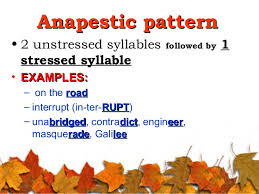

Limericks are short poems of five lines having rhyme structure AABBA. It is officially described as a form of ‘anapestic trimeter’. The ‘anapest’ is a foot of poetic verse consisting of three syllables, the third longer (or accentuated to a greater degree) than the first two: da-da-DA.
Definition of Anapest
Anapest is a poetic device defined as a metrical foot in a line of a poem that contains three syllables wherein the first two syllables are short and unstressed followed by a third syllable that is long and stressed as given in this line “I must finish my journey alone.” Here the anapestic foot is marked in bold.
Example
‘Twas the night before Christmas, when all through the house
Not a creature was stirring, not even a mouse;
The stockings were hung by the chimney with care,…
While visions of sugar plums danced in their heads…
had just settled our brains for a long winter‘s nap….
As dry leaves that before the wild hurricane fly,
when they meet with an obstacle, mount to the sky…
with the sleigh full of toys, and St. Nicholas too.
(‘Twas the Night before Christmas by Clement Clarke Moore)
This poem is a perfect example of anapest, which runs throughout the poem. Most of the lines are following anapestic tetrameter. Like in the first line, there are four anapests. However, three anapests are also used in other lines.
Function of Anapest
It helps create artistic lines with a regular meter in a poem. Since anapest ends in a stressed syllable, it makes strong rhyming lines that create music in a poem. It plays a very important role in poetry and the most common role in verses is that of a comic meter, which is, the foot used in the limerick for comical effects.
Prominent source: http://literarydevices.net/anapest/






























